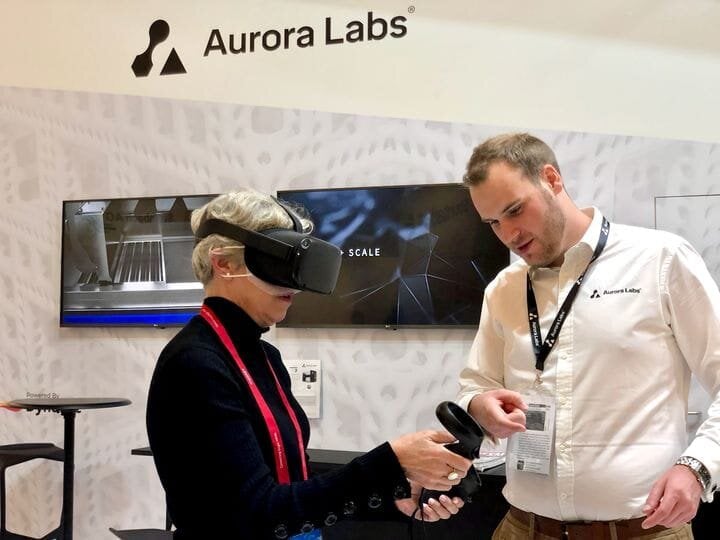
It seems that Aurora Labs is experimenting with a form of virtual reality with their 3D printers.
At Formnext we were able to test a prototype VR system provided by Aurora Labs to curious visitors.
The system involves placing a VR headset on and operating a pair of hand controls. In the demonstration, the VR participant is shown a full-scale virtual replica of Aurora Lab’s flagship 3D printer, the RMB1. It’s possible to “walk around” the virtual device in VR, and even open up the machine to see inside the build chamber.
We were able to “remove” a “completed 3D print” from the virtual RMB1’s build chamber, and that’s about all this particular VR demonstration was able to provide at this very early stage.
In spite of the simplicity of the demonstration, it begs the question of future VR opportunities with 3D printing operational environments. I can foresee several different use cases for VR with metal 3D printing.
3D Printing VR Training?
![The Aurora Labs RMP1 Metal 3D printer, with CEO David Budge in the background [Source: Fabbaloo]](https://fabbaloo.com/wp-content/uploads/2020/05/aurora-rmp1-1_img_5eb08c738f8ab.jpg)
One would be initial training. While it’s always possible to view videos of necessary procedures, doing the “real thing” is always better. However, a VR representation of the “real thing” could be a better learning experience than a video.
It could be possible for Aurora Labs to develop a series of introductory training VR experiences to take an operator through all the normal tasks involved in daily usage. This could be an important dimension of the company’s goal of placing industrial metal 3D printers in remote mining operations, where access to trainers could be problematic.
A second and perhaps more important application of VR for Aurora Labs could be for maintenance and service.
Most industrial 3D printers are sold with a comprehensive service contract, in which an expertly-trained technician would periodically appear on site and perform detailed procedures to maintain proper equipment operation. But that may not be as possible given Aurora Labs’ remote target markets.
Virtual Maintenance For 3D Printers
Instead, it may be possible for Aurora Labs to deploy an on-demand VR maintenance series where local onsite staff could “experience” what has to be done for maintenance and undertake the work themselves once familiar with the task through VR.
It’s also possible fix procedures could be put in VR form so that a local tech could quickly learn how to, say, replace a blown board or other component as required. I could imagine such a library of VR experiences would start with the most commonly encountered scenarios, but could gradually be built up to include most maintenance and service situations.
3D Printing VR Benefits
For remote locations this could be a far faster approach for receiving service, since physically sending a tech might be not only expensive but take days to do. A VR – local service approach could result in less machine downtime.
I’m not sure how far Aurora Labs might want to take this concept, but there are certainly a number of interesting possibilities. The opportunity to save the cost of remote technicians and even the travel cost of technicians could be quite attractive for all involved.
Via Aurora Labs

